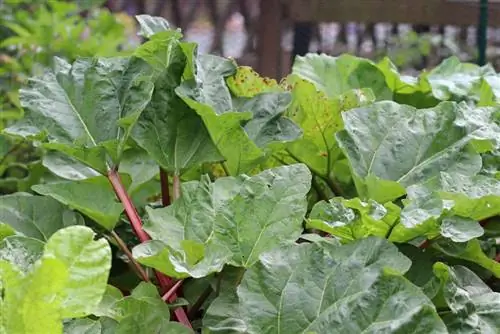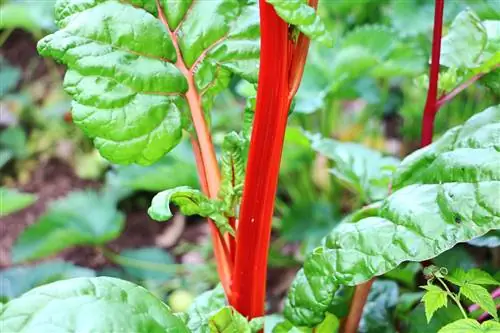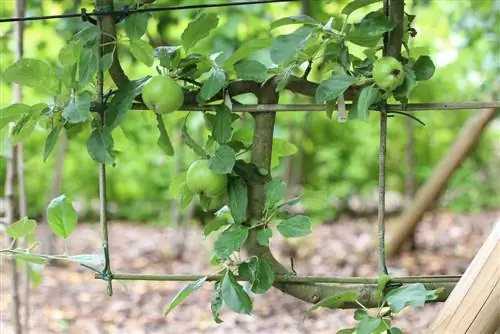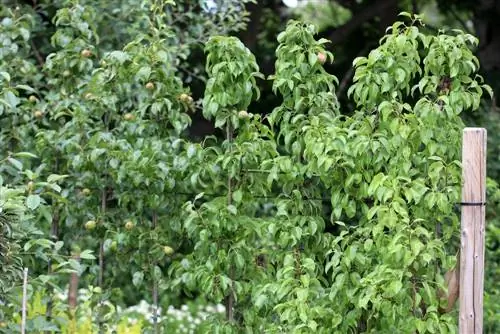- Author admin [email protected].
- Public 2023-12-17 03:39.
- Last modified 2025-01-24 12:45.
Rhubarb also known as common, vegetable or curly rhubarb, is a crop from the knotweed family. The Latin name 'Rheuma rhubarberum' translates as 'root of the barbarians' and refers to its region of origin, Tibet. The strong stems are eaten. They can be eaten raw with restrictions, but above all they can be processed into numerous desserts or cakes. Some parts of the plant are poisonous due to high levels of oxalic acid. But is rhubarb a fruit or a vegetable?
Fruit or vegetables?
Due to the fact that rhubarb is mainly used in sweet dishes such as compotes, jams, desserts and cakes, it is believed to be closer to fruit than to vegetables. Its slightly sour taste is also more likely to be associated with a type of fruit. An argument in favor of fruit could be that vegetables usually have to be sown or grown every year and fruit grows on perennial plants. Nevertheless, it is undisputed that rhubarb is a perennial that, from a botanical point of view, can clearly be classified as a vegetable, even if it can always be found next to fruit on supermarket shelves.
Strictly speaking, rhubarb is a stem vegetable that also includes asparagus, celery and stem or rib chard. What is eaten here is not the fruit heads, but the stems, but not the shoot axis. The stems of stem vegetables usually grow above the ground, bear flowers and leaves and are also fleshy and thickened. These are all properties that also apply to rhubarb.
Tip:
If you place a bucket or large clay pot upside down over the plant in early spring, before budding, the pale stems that appear a few weeks later are particularly tender and mild.
Usable and poisonous parts of plants
Rhubarb is not only very aromatic, but can also strengthen our immune system because it contains important vitamins, minerals and pectins. The Chinese recognized this around 2,700 years BC. BC and from then on use it as a medicinal plant. The rhubarb season begins in April and ends on St. John's Day, June 24th. If possible, you should not consume it again afterwards. The problem with this plant is the high proportion of oxalic acid, which is harmful to he alth if consumed in large quantities.
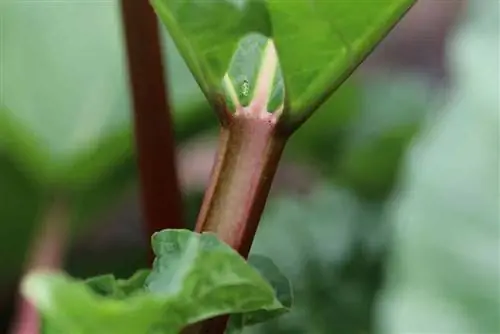
The proportion is particularly high in the leaves, but they are not suitable for consumption anyway. But the stems also contain oxalic acid and the proportion increases slowly but steadily. As a result, consumption after June 24th is not recommended. Until then, the concentration in the stems is classified as harmless, especially if you harvest in April, when the oxalic acid content is still minimal. In normal quantities, you can eat the refreshing vegetables without hesitation during the best harvest time.
Notes on Growing Rhubarb
Rhubarb is a so-called permanent crop; it is planted once, can remain in the same location for around 10 years and can be harvested year after year. Under optimal conditions, it increases in size and yield every year.
- Sunny locations and fertile, loose, deep soils are optimal
- Sandy soil enriched with leaf humus is best suited
- Rhubarb shouldn’t be in too shady
- In dark locations the stems remain very thin
- The space required by a single plant is approximately one square meter
After the harvest, it is advisable to provide the plants with compost and some mineral fertilizer so that they can go into winter rest well strengthened. From October onwards no maintenance is required. You can also do without winter protection.
Tip:
Rhubarb can usually be harvested for the first time from the 3rd year onwards.
A vegetable with high ornamental value
The rhubarb flower buds are usually broken out in April/May to benefit the stems. But the flowers in particular have a very high ornamental value and are extremely decorative. It is often said that rhubarb can no longer be eaten during flowering, but this is not proven anywhere.
If you place particular value on the delicate and very decorative flowers, it is best to leave two or three flower shoots standing. Or you can opt for pure ornamental rhubarb, for example crown rhubarb or Siberian ornamental rhubarb. This impressive ornamental perennial grows up to 200 cm tall and enchants with its beautiful red flowers from May to July. Their initially green and later reddish leaves as well as the seed heads also have a high ornamental value.
Popular varieties
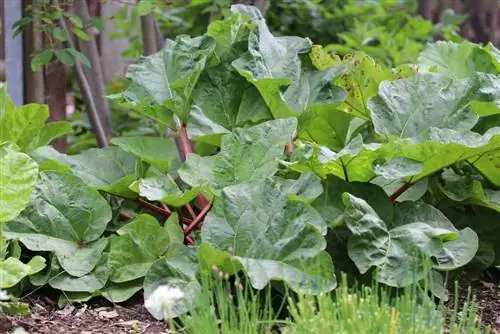
Among the approximately 60 species of this vegetable plant, there are a few varieties that are particularly popular. Green-skinned varieties contain the most acid. Rhubarb with green flesh and reddish skin are much milder. Varieties with red skin and red flesh are the sweetest. Which variety of this vegetable you ultimately choose is a question of personal taste.
Food rhubarb 'Holsteiner Blut'
The approx. The 60 cm high stems of this proven, mid-early and very winter-hardy classic have red stems with predominantly greenish to pink flesh. They have a noticeably mild taste. If you break off cream-colored flowers completely, the harvest will be correspondingly higher.
Food rhubarb 'Rosara'
This edible rhubarb is also extremely productive. Its stems are up to 40 cm long, green-fleshed with a reddish skin and the flowers are cream-colored.
Food Rhubarb 'Goliath'
Among all edible rhubarbs, the 'Goliath' variety is a real giant. The green-fleshed, reddish stems of this high-yielding variety can reach a length of up to 90 cm. They have a slightly sour, strong taste. The cream-colored flowers can be a real eye-catcher in the garden. As with all varieties, the best harvest time is from April to June.
Raspberry-rhubarb 'Frambozen Rood'
This raspberry rhubarb, also called rose rhubarb, surprises with an intense, fruity-fresh taste. Its stems are red-skinned with green flesh. They smell pleasantly of raspberries and are so tender that they can also be eaten unpeeled.
Rhubarb 'Red Valentine'
This rhubarb is a variety from Canada with red skin and red flesh. In a particularly warm spring, the stems may remain light. Compared to other varieties, the stems remain comparatively small with a length of 30 cm.
Conclusion
Rhubarb is a somewhat unusual but still very aromatic and tasty vegetable. Even if some people would classify it as fruit, that doesn't detract from its individuality. If you can't get used to the special taste of rhubarb, you could at least benefit from the attractiveness of its flowers.

